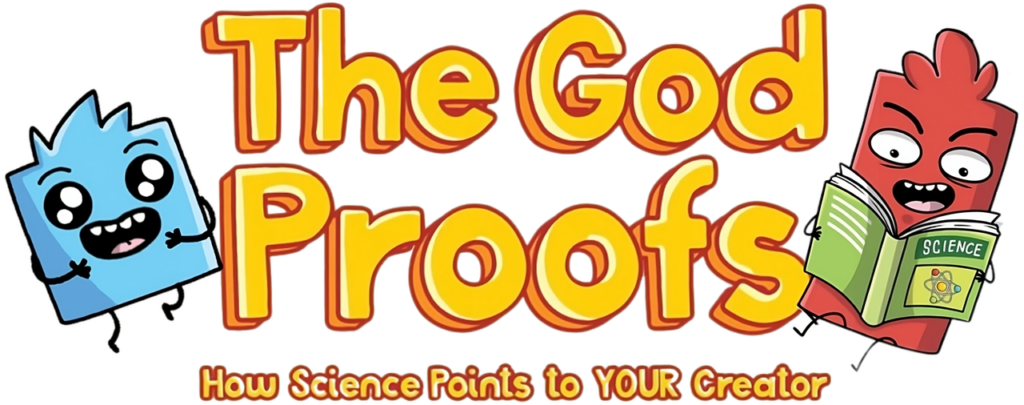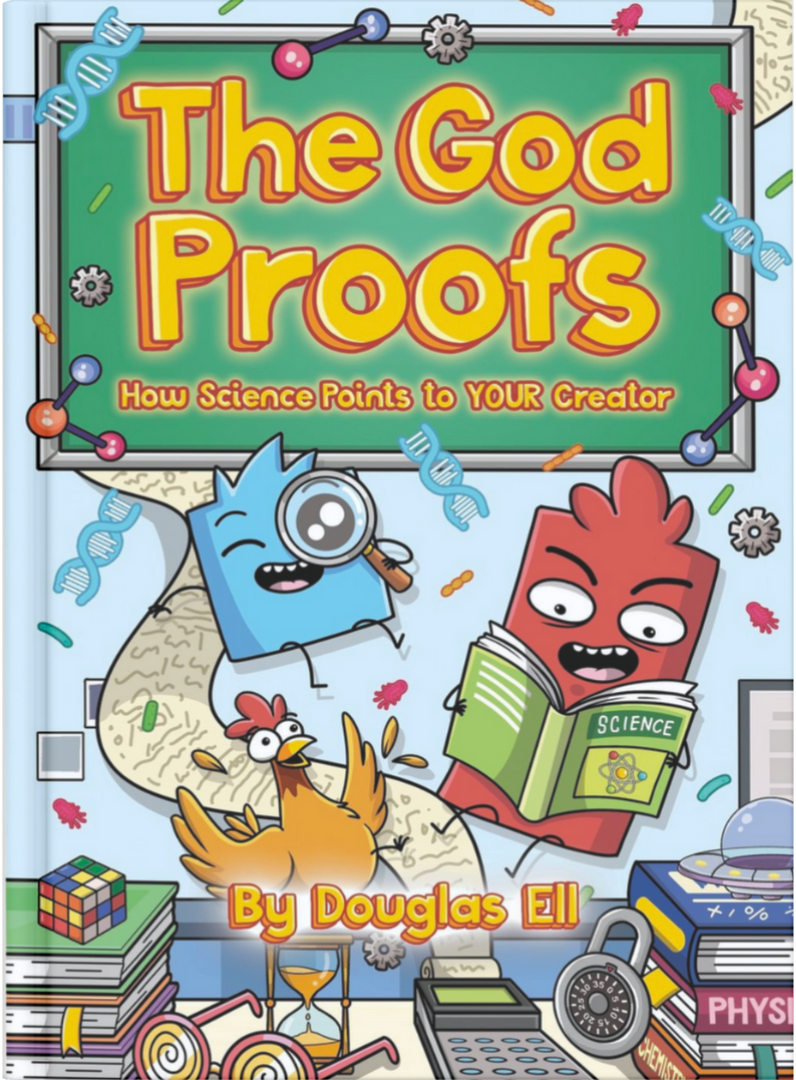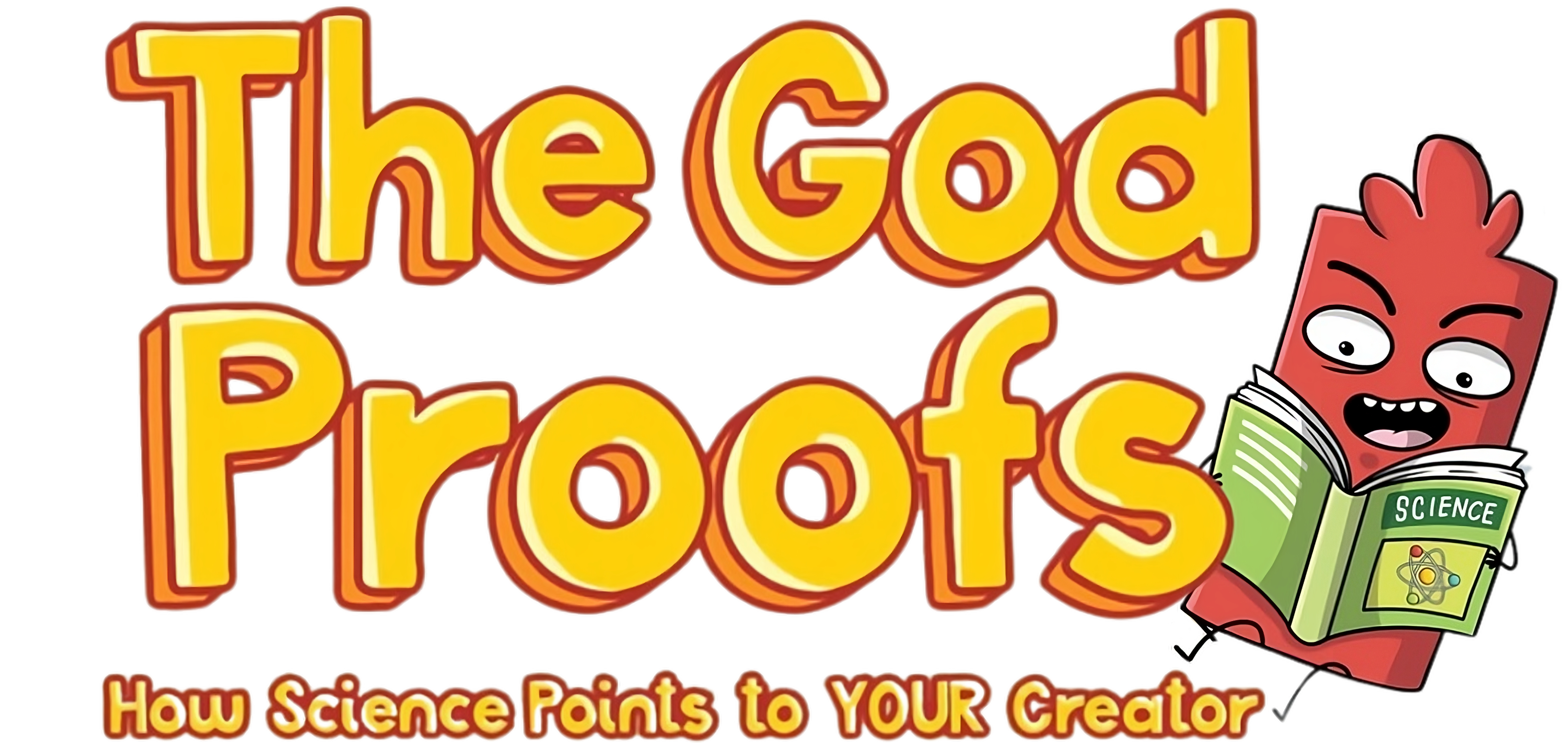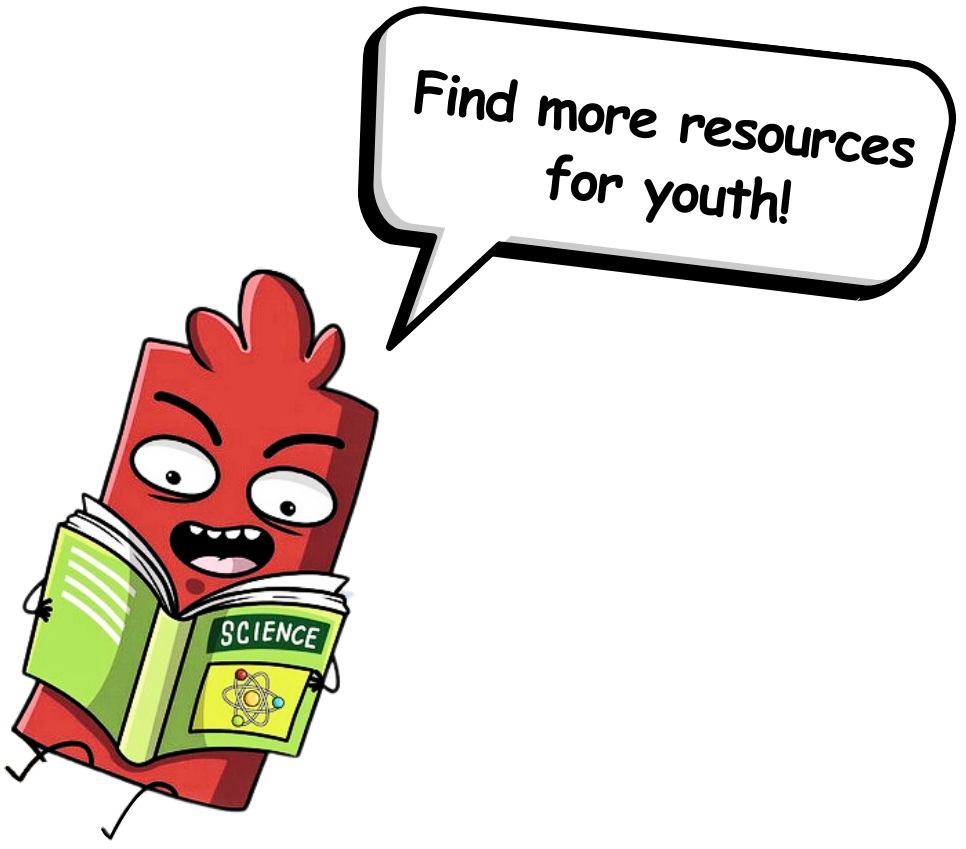Book Summary
Join two friends on an epic journey to tackle the ultimate mystery—does God exist? In this graphic novel, follow our dynamic duo as they explore the wonders of science, challenge each other’s beliefs, and uncover mind-boggling facts about the universe.
Author
Douglas Ell
References
(p. 33) For the number of sections of DNA that are switches, see Gina Kolata, “Bits of Mystery DNA, Far From ‘Junk,’ Play Crucial Role,” The New York Times, September 5, 2012.
(pp. 36-43) Explanation of calculations: This example of chickens pecking illustrates the enormous odds against getting a specified sequence of 185 typewritten characters by random chance. The text assumes you have a choice of 29 letters/symbols at each position; there are more keys on a typewriter, but using just 29 choices at each position is sufficient to make the point. Multiplying 29 by itself 185 times yields roughly 10^270, or, using the concept of a probability wall developed in the text, a probability wall 270 feet high.
Read More
The text then proves that the “probabilistic resources” of the entire universe do not yield enough chances to overcome this wall. For this purpose, the text assumes 10^90 atoms in the universe. No one knows how many atoms there are in the universe, but most estimates are in the 10^80 range, so using the much larger number of 10^90 (ten billion times larger) as the number of atoms/chickens again drives the point home. The chickens are then assumed to be typing one letter each unit of Planck time, which is generally believed to be the smallest possible unit of time using the laws of physics as we understand them today. There are about 2 times 10^43 units of Planck time in each second, so again we use a more generous number, 10^44, to drive the point home. We then multiply 10^90 atoms/chickens each typing 10^44 letters each second for 3 times 10^7 seconds (number of seconds in a year) in each of 10^24 years (a trillion trillion years) to get roughly 3 times 10^156 chances (156 = 90 + 44 + 7 + 24). Clearly, the entire probabilistic resources of the universe, even when using wildly excessive assumptions about that number, fall far short (far below 1 in 10^100) of any realistic chance of getting that specified sequence of 185 typewritten characters by random chance. In the real world, the chickens can’t get it right.
(pp. 49-50) Lock and probability ladder: Odds of opening lock with one chance = 1 in 29^185 = 1 in 3.5 x 10^270 (probability wall about 270 feet high). Number of chances = 10^90 atoms x 10^44 chances per second x 3 x 10^7 seconds per year x 10^24 years= 3 x 10^156 (opportunity ladder about 156 feet high). Odds of opening lock with all those chances about 1 in 10^114 (top of ladder is 114 feet below top of wall).
(p. 53) Getting new working DNA code by chance: Put more precisely, scientists have found that getting any new working DNA code to produce a new type of protein by chance is so unlikely that it would never occur by blind evolutionary mechanisms. See Douglas D. Axe, “Estimating the Prevalence of Protein Sequences Adopting Functional Enzyme Folds,” Journal of Molecular Biology, 341, no. 5 (August 24, 2004): 1295-1315; Douglas D. Axe, “Extreme Functional Sensitivity to Conservative Amino Acid Changes on Enzyme Exteriors,” Journal of Molecular Biology, 301, no. 3 (Aug. 18, 2000): 585–595.
(pp. 54-55) If you’d like more information on why the odds of creating a meaningful English sentence is vanishingly low, try asking this question of one of the big AI chatbots: “If you had a sequence of 100 random English letters and spaces, what are the odds that the sequence will be made up of real words that make grammatical sense?” See what answer you get! Regarding the marbles: Simple math, using common assumptions about the size of the universe, shows that 10^100 marbles would more than fill a universe hundreds of billions of light years in each direction. Many scientists estimate the size of the visible universe as around 100 billion light years in each direction.
(p. 56) Odds that a short amino acid sequence would build a particular part: John F. Reidharr-Olson and Robert T. Sauer, “Functionally acceptable substitutions in two α-helical regions of λ repressor,” Proteins: Structure, Function, and Bioinformatics, vol. 7 (1990), 306-316.
(p. 57) Douglas Axe, “Estimating the Prevalence of Protein Sequences Adopting Functional Enzyme Folds,” Journal of Molecular Biology, 341, no. 5 (August 24, 2004): 1295-1315.
(p. 58) Explanation of calculation: The radius of a hydrogen atom is about 10^-10 meters, so there would be about 10^20 of them in a square meter. Two hundred billion light years is roughly 2 times 10^24 meters, so a piece of paper 200 billion light years on a side has about 4 times 10^48 square meters, and would therefore hold about four times 10^68 hydrogen atoms. So the odds of hitting the hydrogen atom on the piece of paper are one in four times 10^68 meters, so 2.5 times 10^-69. Note that this probability is over one thousand times greater than a probability of one in 10^74. In other words, the probability of getting a functional protein in a random sequence of 150 amino acids is more than 1,000 times less than the odds of hitting the dot in the example.
(p. 59) A light year is the distance light travels in one year, which is about 6 trillion (6,000,000,000,000) miles. Two hundred billion light years is about 1,200 billion trillion miles.
(p. 59) There haven’t been enough chances: Estimates for the number of organisms that have ever lived are usually below 10^30. The vast majority of these are bacteria or other creatures with one cell, and they don’t live very long, but let’s be generous and say 1,000 mutations for each. That gives a number with 33 zeros for the number of mutations ever, an opportunity ladder 33 feet high. Even that is still way, way short of a 74 foot probability wall.
(p. 67) Unique code in jellyfish: Helen Pilcher, “All Alone,” New Scientist, 217, no. 2900 (January 19, 2013): 40-43.
(p. 67) Unique code for building human brain: Helen Pilcher, “All Alone,” New Scientist, 217, no. 2900 (January 19, 2013): 40-43.
(p. 68) Octopuses so different they could be from outer space: Katherine Hignett, “Are Octopuses From Outer Space? Study Suggests Cephalopod Eggs Traveled to Earth on a Comet,” Newsweek, May 17, 2018.
(pp. 69-70) Unique genes in leaf-cutter ants: Lothar Wissler, Jürgen Gadau, Daniel Simola, et al., “Mechanisms and Dynamics of Orphan Gene Emergence in Insect Genomes,” Genome Biology and Evolution, vol. 5, no. 2 (2013): 439-455; Daniel Simola, Lothar Wissler, et al., “Social insect genomes exhibit dramatic evolution in gene composition and regulation while preserving regulatory features linked to sociality,” Genome Research, vol. 23 (2013): 1235-1247.
(p. 70) Orphan genes: K. Khalturin, G. Hemmrich, S. Fraune, R. Augistin, and T.C. Bosch, “More Than Just Orphans: Are Taxonomically-Restricted Genes Important in Evolution?” Trends in Genetics, 25, no. 9 (2009): 404-13.
(p. 72) About the ENCODE project: ENCODE is an international collaboration of over 400 top scientists, working together, with no religious agenda, “to build a comprehensive parts list of functional elements in the human genome.” In 2012, they simultaneously released 30 major papers. The front page of the New York Times announced: “The human genome is packed with at least four million gene switches that reside in bits of DNA that once were dismissed as ‘junk’ but that turn out to play critical roles in controlling how cells, organs and other tissues behave.” Also see The ENCODE Project Consortium, “An integrated encyclopedia of DNA elements in the human genome,” Nature, vol. 489 (2012): 57-74.
(p. 76) Humans’ special DNA code for building the brain: Helen Pilcher, “All Alone,” New Scientist, 217, no. 2900 (January 19, 2013): 40-43; Orphan genes: K. Khalturin, G. Hemmrich, S. Fraune, R. Augistin, and T.C. Bosch, “More Than Just Orphans: Are Taxonomically-Restricted Genes Important in Evolution?” Trends in Genetics, 25, no. 9 (2009): 404-13.
(pp. 78-79) Chance and design: Sometimes chemical evolutionists will claim that there is a third option to generate code—necessity or natural law, or chance + necessity. For explanations of why necessity/law explanations don’t work to generate new working code, see Stephen Meyer, Signature in the Cell: DNA and the Evidence for Intelligent Design (New York: HarperOne, 2009), chapters 11 and 13. More generally, for an explanation for why it is legitimate to describe the two basic options as chance and design, see William Dembski and Winston Ewert, The Design Inference: Eliminating Chance through Small Probabilities, second edition (Seattle: Discovery Institute Press, 2023), especially pp. 83, 222-229, 249-250.
(p. 90) Complexity of the brain: Michael Blaustein, “The human brain sees the world as an 11-dimensional multiverse,” New York Post, June 13, 2017; Michael W. Reimann, et al., “Cliques of Neurons Bound into Cavities Provide a Missing Link between Structure and Function,” Frontiers in Computational Neuroscience, vol. 11 (2017), June 12, 2017.
(p. 91) Information about neurons: Sandra Ackerman, Discovering the Brain (Washington DC: Institute of Medicine, National Academy of Sciences, 1992), chapter 6, available online. Regarding the number of synapses in humans, see “Synapse vulnerability and resilience underlying Alzheimer’s disease,” eBioKMedicine, vol. 112, no. 105557 (February 2025): “Synapses are nanomolecular structures that contain up to 6’000 proteins per synapse, are present at around 10’000 synapses per neuron, have a density of 1 trillion synapses per cm^3 in the human brain, and show intimate associations with glial cells.”
(p. 91) On neurons transmitting light, see Luke Auburn, “Do neurons transmit light?” University of Rochester (April 14, 2025).
(p. 92) On the relative efficiency of the human brain, see “The energy challenges of artificial superintelligence,” Frontiers in Artificial Intelligence, vol. 6 (October 23, 2023): “we arrive at 2.7 × 10^13 as the total relative efficiency of the human brain vs. silicone semiconductor processors running AI algorithms.”
(p. 111) Unique codes to building human brain: Humans’ special DNA code for building the brain: Helen Pilcher, “All Alone,” New Scientist, 217, no. 2900 (January 19, 2013): 40-43.
(pp. 121-122) Casey Luskin, “No, Scientists in Darwin’s Day Did Not Grasp the Complexity of the Cell; Not Even Close,” Evolution News and Science Today, June 6, 2013, https://evolutionnews.org/2013/06/did_scientists_/.
(p. 126) “Peacock colors inspire ‘greener’ way to dye clothes,” Science Daily, Feb. 1, 2017, https://www.sciencedaily.com/releases/2017/02/170201110550.htm.
(pp. 134-135) For more information about changes in moths, see Jonathan Wells, Icons of Evolution: Science or Myth? Why Much of What We teach about Evolution Is Wrong (Washington, DC: Regnery Publishing, 2000), 137-157; Jonathan Wells, Zombie Science: More Icons of Evolution (Seattle: Discovery Institute Press, 2017), 63-66.
(pp. 136-137) For more information on the microevolution of finches on the Galápagos Islands, see Jonathan Wells, Icons of Evolution: Science or Myth? Why Much of What We teach about Evolution Is Wrong (Washington, DC: Regnery Publishing, 2000), 159-175; Jonathan Wells, Zombie Science: More Icons of Evolution (Seattle: Discovery Institute Press, 2017), 67-69.
(p. 139) For more details on the long-term evolution experiment with bacteria: Michael Behe, Darwin Devolves: The New Science about DNA that Challenges Evolution (New York: HarperOne, 2019), 175 and Michael Behe, “Lenski’s Long-Term Evolution Experiment: 25 Years and Counting,” Evolution News and Science Today, Nov. 21, 2013.
(p. 140) More on natural selection: In many cases, natural selection works to preserve a breakdown in technology that confers, for that particular creature, an advantage. A classic example is sickle-cell anemia. Sickle-cell anemia is a human blood disease that, as a side effect, creates greater resistance to malaria. The malaria virus doesn’t thrive as well where sickle-cell anemia is present, so sickle-cell anemia has spread in parts of the world where malaria is common. See the discussion of this case in Michael Behe’s book The Edge of Evolution: The Search for the Limits of Darwinism (New York: Free Press, 2007).
(pp. 141-143) Cavefish and evolution: Michael J. Boyle et al., “Testing the Cavefish Model: An Organism-focused Theory of Biological Design,” Proceedings of the International Conference on Creationism, vol. 9, article 78 (2023).
(pp. 154-162) For more information and documentation about navigation in animals, see Eric Cassell, Animal Algorithms: Evolution and the Mysterious Origin of Ingenious Instincts (Seattle: Discovery Institute Press, 2021), 35-83.
(p. 160) For information about magnetotactic bacteria, watch “Bacteria: Superheroes of the Microbial World.”
(pp. 161-162) For more information about the incredible story of the monarch migration as well as the exquisite intelligent design of butterflies, watch the documentary Metamorphosis: The Beauty and Design of Butterflies.
(p. 170) For information about scientists persecuted for doubting Darwin, visit the website FreeScience.today.
(p. 173) Evolution of the appendix: “Pretty Useful: Appendix Evolved More Than 30 Times,” Science Now/Wired.com, February 13, 2013.
(p. 182) Yale professor who calculated the odds of life by chance: Harold Morowitz, Energy Flow in Biology (New York: Academic Press, 1968). More generally, one of the top current chemists in the world is James Tour. In January 2019 he gave an excellent lecture on the impossibility of getting life by chance.
(pp. 186-188) For more information about the Miller-Urey experiment, see Jonathan Wells, Icons of Evolution: Science or Myth? Why Much of What We teach about Evolution Is Wrong (Washington, DC: Regnery Publishing, 2000), 9-27; Jonathan Wells, Zombie Science: More Icons of Evolution (Seattle: Discovery Institute Press, 2017), 50-56.
(pp. 189-190) Information on Harvard origin of life project and its 2009 conference: Anna Kushnir, “The Origins of Life on Earth. Really,” BostonBlog, March 9, 2009. The dramatic change of focus in the project can be seen by comparing a description of the project in 2011 with its current description. In 2011, the question of how life originated was front and center. By 2024, the focus had shifted to the question “Is life abundant in the Universe?” Compare “About the Origins of Life Initiative,” Harvard University, as of April 26, 2011, with “Overview,” Origins of Life Initiative, Harvard University” (accessed March 28, 2024).
Reviews
In a book of magnificent sweep and daring Guillermo Gonzalez and Jay Richards drive home the arguments that the old cliché of no place like home is eerily true of Earth. Not only that, but if the scientific method was to emerge anywhere, the Earth is about as suitable as you can get. Gonzalez and Richards have flung down the gauntlet. Let the debate begin; it is a question that involves us all.
Simon Conway Morris
Professor of Evolutionary Paleobiology, University of Cambridge
Author of Life’s Solution: Inevitable Humans in a Lonely Universe
This thoughtful, delightfully contrarian book will rile up those who believe the “Copernican principle” is an essential philosophical component of modern science. Is our universe designedly congenial to intelligent, observing life? Passionate advocates of the search for extraterrestrial intelligence (SETI) will find much to ponder in this carefully documented analysis.
Owen Gingerich
Harvard-Smithsonian Center for Astrophysics
Author of The Book Nobody Read: Chasing the Revolutions of Nicolaus Copernicus
Read More
Not only have Guillermo Gonzalez and Jay Richards written a book with a remarkable thesis, they have constructed their argument on an abundance of evidence and with a cautiousness of statement that make their volume even more remarkable. In my opinion, The Privileged Planet deserves very careful attention.
Michael J. Crowe
Cavanaugh Professor Emeritus, University of Notre Dame
Author of The Extraterrestrial Life Debate, 1750–1900
Impressively researched and lucidly written, The Privileged Planet will surely rattle if not finally dislodge a pet assumption held by many interpreters of modern science: the so-called Copernican Principle (which isn’t actually very Copernican!). But Gonzalez and Richards’ argument, though controversial, is so carefully and moderately presented that any reasonable critique of it must itself address the astonishing evidence which has for so long somehow escaped our notice. I therefore expect this book to renew—and to raise to a new level—the whole scientific and philosophic debate about earth’s cosmic significance. It is a high class piece of work that deserves the widest possible audience.
Dennis Danielson
Professor of English, University of British Columbia
Editor of The Book of the Cosmos: Imagining the Universe from Heraclitus to Hawking
Gonzalez and Richards have written a book that is at once inspiring, illuminating, and beautiful. Although the 20th century insights in quantum physics should long ago have dispelled the simplistic idea that nature is nothing more than matter in motion, The Privileged Planet suggests that scientific discovery is embedded in the very structure of the cosmos. With uncommonly engaging prose, they offer a virtual tour of the marvels of modern science and the discoveries science has brought to light, from geology to cosmology. The authors also suggest intriguing answers to ubiquitous “cosmic questions”: Why have we been able to discover so much about the world around us in such a short time? Is extraterrestrial life common, or is it quite rare? What is Earth’s place in the cosmos? Does the universe exist for a purpose? Only those interested in these questions — but who isn’t? — should read this book.
George Gilder
Author of The Bestselling Book Telecosm
Founder of Gilder Technology Report
In this fascinating and highly original book, Guillermo Gonzalez and Jay Richards advance a persuasive argument, and marshal a wealth of diverse scientific evidence to justify that argument. In the process, they effectively challenge several popular assumptions, not only about the nature and history of science, but also about the nature and origin of the cosmos. The Privileged Planet will be impossible to ignore. It is likely to change the way we view both the scientific enterprise and the world around us. I recommend it highly.
Philip Skell
Evan Pugh Professor Emeritus of Physics, Pennsylvania State University
Member of National Academy of Sciences
This new book is an excellent and timely contribution to the broadening and increasingly important discussion of origins.
Henry F. Schaefer III
Professor of Chemistry, Graham Perdue
Director of Center for Computational Quantum Chemistry, University of Georgia
Five-Time Nobel Prize Nominee
Privileged Planet is simply a beautifully written piece of work: so lucid and compelling in its presentation that even the most lay of laypersons will fly through its pages, barely able to put the book down. And when is the last time that hard science has delivered such an optimistic, even joyful message? For Gonzalez and Richards have made the incontrovertible case that this earth of ours is not just some flyspeck of inconsequentiality in a meaningless universe, but holds a rare, even honored place, and that we, its inhabitants, are especially privileged to be here.
Joshua Gilder
Former White House Speech Writer
Author of Heavenly Intrigue: Brahe, Kepler and the Birth of Modern Science





